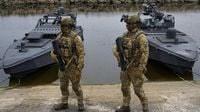Ukraine’s state security service has pulled back the curtain on a remarkable leap in naval warfare. On October 23 and 24, 2025, officials introduced an upgraded unmanned sea drone, the “Sea Baby,” which, according to the Security Service of Ukraine (SBU), is poised to reshape the balance of power in the Black Sea. This new iteration boasts a range of 1,500 kilometres—up from its previous 1,000—enabling it to operate across the entire Black Sea and strike targets previously out of reach.
The SBU has not been shy about the drone’s capabilities. The Sea Baby’s payload capacity now sits at a hefty 2,000 kilograms, a significant increase that allows it to carry an array of weaponry. During a demonstration for the media, Ukraine’s security officials showcased variants of the drone: one bristling with a multiple-rocket launcher, another fitted with a stabilised machine-gun turret. The message was clear—these are not mere surveillance tools, but formidable offensive platforms.
But hardware is only part of the story. The upgraded Sea Baby leverages artificial intelligence for friend-or-foe identification and targeting, a feature that SBU Brigadier General Ivan Lukashevych called a world first in naval warfare. “The SBU became the first in the world to pioneer this new kind of naval warfare — and we continue to advance it,” Lukashevych said, as reported by BBC and Reuters. This AI assistance, paired with the drone’s ability to launch small aerial attack drones, gives Ukraine a flexible, multi-layered strike capability. And should the drone risk falling into enemy hands, it’s equipped with multilayered self-destruct systems, ensuring that sensitive technology doesn’t become a Russian prize.
What’s it like to operate one of these high-tech vessels? The SBU offered a rare glimpse inside the mobile control center—a van packed with screens and controls, where operators guide the drone via remote link. According to one operator, identified only by his call sign “Scout,” cohesion among the crew is paramount. “Cohesion of the crew members is probably the most important thing. We are constantly working on that,” he explained, underscoring the human element behind the technology.
The Sea Baby has already earned its stripes in combat. Ukrainian officials credit these drones with successful strikes on 11 Russian vessels, including frigates and missile carriers—a tally that has not gone unnoticed in Moscow. The SBU claims these attacks forced the Russian navy to relocate its main Black Sea base from the strategic port of Sevastopol in Crimea to Novorossiysk, further east on Russia’s own coast. This shift, according to Ukraine’s security service, represents a major strategic win and demonstrates the disruptive potential of unmanned naval warfare.
The drones’ reach extends beyond ships. According to The Guardian, Sea Babies have played a role in repeated attacks on the Crimean Bridge—a vital supply line for Russian forces. The most recent strikes reportedly targeted the bridge’s underwater supports, aiming to render it unusable for heavy military transport. These operations, coordinated with Ukraine’s military and political leadership, highlight the evolving role of sea drones in the broader conflict.
Funding for the Sea Baby program is as innovative as the technology itself. While the initiative is directed by the SBU and closely coordinated with Ukraine’s top brass, it’s also partly bankrolled by public donations through a state-run initiative. Lukashevych pointed out that the evolution from single-use strike craft to reusable, networked platforms is a testament to the effective use of these contributions. “Here we can show Ukrainians the most effective use of the money they have donated to us,” he said, offering a rare note of transparency in military procurement.
Security concerns remain front and center. For the demonstration, authorities declined to reveal the time and location, citing operational safety. This secrecy is a reminder of the ever-present risks and the high stakes at play in the Black Sea theater.
The Sea Baby’s transformation from a one-way strike vessel to a reusable, multi-mission platform marks a milestone in what military analysts call asymmetric warfare. In traditional naval battles, larger, heavily armed ships have long dominated. But Ukraine’s use of relatively inexpensive, agile drones is rewriting the rules. These platforms can now deliver heavy weaponry from well beyond the range of enemy defenses, as Lukashevych emphasized: “On this new product, we have installed rocket weaponry that will allow us to work from a large distance outside of the attack range of enemy fire. We can use such platforms to carry heavy weaponry.”
It’s a shift that’s being watched closely not just in Kyiv and Moscow, but in naval headquarters around the world. The SBU’s success with the Sea Baby program has already prompted Russia to rethink its Black Sea posture, and it’s likely to influence future naval doctrine far beyond the region. The integration of AI, remote piloting, and modular weapon systems suggests a future where unmanned vessels play an ever-larger role in maritime security and conflict.
For Ukraine, the Sea Baby is more than just a weapon—it’s a symbol of resilience and innovation in the face of overwhelming odds. The country’s ability to crowdsource funding, rapidly iterate on technology, and deploy new tools in the heat of conflict has given it an edge in a war where conventional advantages often favor the larger, better-equipped Russian military.
Yet, as with any technological leap, questions linger. How will Russia respond to this new threat? Will other nations follow Ukraine’s lead in developing similar drones? And what does the rise of AI-driven, remote-controlled warfare mean for the future of naval engagements? These are not just technical issues—they touch on ethics, international law, and the very nature of modern conflict.
For now, the Sea Baby stands as a testament to Ukraine’s ingenuity and determination. In a war defined by shifting front lines and evolving tactics, this humble drone—operated from the back of a van, funded by ordinary citizens, and powered by cutting-edge AI—has forced one of the world’s largest navies to change course. That’s no small feat, and it’s a story that’s still being written on the waves of the Black Sea.
